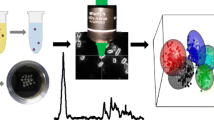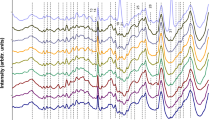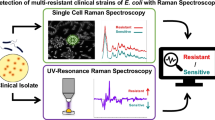Abstract
The identification of pathogenic bacteria is a frequently required task. Current identification procedures are usually either time-consuming due to necessary cultivation steps or expensive and demanding in their application. Furthermore, previous treatment of a patient with antibiotics often renders routine analysis by culturing difficult. Since Raman microspectroscopy allows for the identification of single bacterial cells, it can be used to identify such difficult to culture bacteria. Yet until now, there have been no investigations whether antibiotic treatment of the bacteria influences the Raman spectroscopic identification. This study aims to rapidly identify bacteria that have been subjected to antibiotic treatment on single cell level with Raman microspectroscopy. Two strains of Escherichia coli and two species of Pseudomonas have been treated with four antibiotics, all targeting different sites of the bacteria. With Raman spectra from untreated bacteria, a linear discriminant analysis (LDA) model is built, which successfully identifies the species of independent untreated bacteria. Upon treatment of the bacteria with subinhibitory concentrations of ampicillin, ciprofloxacin, gentamicin, and sulfamethoxazole, the LDA model achieves species identification accuracies of 85.4, 95.3, 89.9, and 97.3 %, respectively. Increasing the antibiotic concentrations has no effect on the identification performance. An ampicillin-resistant strain of E. coli and a sample of P. aeruginosa are successfully identified as well. General representation of antibiotic stress in the training data improves species identification performance, while representation of a specific antibiotic improves strain distinction capability. In conclusion, the identification of antibiotically treated bacteria is possible with Raman microspectroscopy for diverse antibiotics on single cell level.

ᅟ



Similar content being viewed by others
References
Levy SB (2005) Antibiotic resistance—the problem intensifies. Adv Drug Delivery Rev 57(10):1446–1450. doi:10.1016/j.addr.2005.04.001
Hranjec T, Rosenberger LH, Swenson B, Metzger R, Flohr TR, Politano AD, Riccio LM, Popovsky KA, Sawyer RG (2012) Aggressive versus conservative initiation of antimicrobial treatment in critically ill surgical patients with suspected intensive-care-unit-acquired infection: a quasi-experimental, before and after observational cohort study. Lancet Infect Dis 12 (10):774–780. doi:10.1016/S1473-3099(12)70151-2
Paul M, Kariv G, Goldberg E, Raskin M, Shaked H, Hazzan R, Samra Z, Paghis D, Bishara J, Leibovici L (2010) Importance of appropriate empirical antibiotic therapy for methicillin-resistant Staphylococcus aureus bacteraemia. J Antimicrob Chemother 65(12):2658–2665. doi:10.1093/jac/dkq373
Retamar P, Portillo MM, López Prieto MD, Rodríguez López F, De Cueto M, García MV, Gómez MJ, Del Arco A, Munoz A, Sánchez Porto A, Torres Tortosa M, Martín Aspas A, Arroyo A, García Figueras CAF, Corzo JE, León Ruiz L, Escobar Lara T, Rodríguez Bano J, Group SSB (2012) Impact of inadequate empirical therapy on the mortality of patients with bloodstream infections: a propensity score-based analysis. Antimicrob Agents Chemother 56(1):472–478. doi:10.1128/aac.00462-11
Bloos F, Sachse S, Kortgen A, Pletz MW, Lehmann M, Straube E, Riedemann NC, Reinhart K, Bauer M (2012) Evaluation of a polymerase chain reaction assay for pathogen detection in septic patients under routine condition: an observational study. PLoS ONE 7(9):e46003. doi:10.1371/journal.pone.0046003
Buchan BW, Riebe KM, Ledeboer NA (2012) Comparison of the MALDI Biotyper system using Sepsityper specimen processing to routine microbiological methods for identification of bacteria from positive blood culture bottles. J Clin Microbiol 50(2):346–352. doi:10.1128/jcm.05021-11
Fykse EM, Langseth B, Olsen JS, Skogan G, Blatny JM (2008) Detection of bioterror agents in air samples using real-time PCR. J Appl Microbiol 105(2):351–358. doi:10.1111/j.1365-2672.2008.03750.x
Ottesen EA, Hong JW, Quake SR, Leadbetter JR (2006) Microfluidic digital PCR enables multigene analysis of individual environmental bacteria. Science 314(5804):1464–1467. doi:10.1126/science.1131370
Cherkaoui A, Hibbs J, Emonet TM, Girard M, Francois P, Schrenzel J (2010) Comparison of two matrix-assisted laser desorption ionization–time of flight mass spectrometry methods with conventional phenotypic identification for routine bacterial speciation. J Clin Microbiol 48(4):1169–1175. doi:10.1128/jcm.01881-09
Croxatto A, Prod'hom G, Greub G (2012) Applications of MALDI-TOF mass spectrometry in clinical diagnostic microbiology. FEMS Microbiol Rev 36(2):380–407. doi:10.1111/j.1574-6976.2011.00298.x
Wieser A, Schneider L, Jung J, Schubert S (2012) MALDI-TOF MS in microbiological diagnostics—identification of microorganisms and beyond (mini review). Appl Microbiol Biotechnol 93(3):965–974. doi:10.1007/s00253-011-3783-4
Anderson NW, Buchan BW, Riebe KM, Parsons LN, Gnacinski S, Ledeboer NA (2012) Effects of solid-medium type on routine identification of bacterial isolates by use of matrix-assisted laser desorption ionization-time of flight mass spectrometry. J Clin Microbiol 50(3):1008–1013. doi:10.1128/jcm.05209-11
March-Rosselló GA, Muñoz-Moreno MF, García-Loygorri-Jordán de Urriés MC, Bratos-Pérez MA (2012) A differential centrifugation protocol and validation criterion for enhancing mass spectrometry (MALDI-TOF) results in microbial identification using blood culture growth bottles. Eur J Clin Microbiol Infect Dis 32(5):699–704. doi:10.1007/s10096-012-1797-1
Szabados F, Michels M, Kaase M, Gatermann S (2011) The sensitivity of direct identification from positive BacT/ALERT™ (bioMérieux) blood culture bottles by matrix-assisted laser desorption ionization time-of-flight mass spectrometry is low. Clin Microbiol Infect 17(2):192–195. doi:10.1111/j.1469-0691.2010.03229.x
Juiz PM, Almela M, Melción C, Campo I, Esteban C, Pitart C, Marco F, Vila J (2012) A comparative study of two different methods of sample preparation for positive blood cultures for the rapid identification of bacteria using MALDI-TOF MS. Eur J Clin Microbiol Infect Dis 31(7):1353–1358. doi:10.1007/s10096-011-1449-x
Beekes M, Lasch P, Naumann D (2007) Analytical applications of Fourier transform-infrared (FT-IR) spectroscopy in microbiology and prion research. Vet Microbiol 123 (4):305–319. doi:10.1016/j.vetmic.2007.04.010
Bosch A, Miñán A, Vescina C, Degrossi J, Gatti B, Montanaro P, Messina M, Franco M, Vay C, Schmitt J, Naumann D, Yantorno O (2008) Fourier transform infrared spectroscopy for rapid identification of nonfermenting gram-negative bacteria isolated from sputum samples from cystic fibrosis patients. J Clin Microbiol 46(8):2535–2546. doi:10.1128/jcm.02267-07
Harz M, Rösch P, Popp J (2009) Vibrational spectroscopy—a powerful tool for the rapid identification of microbial cells at the single-cell level. Cytometry Part A 75A(2):104–113. doi:10.1002/cyto.a.20682
Wenning M, Büchl NR, Scherer S (2010) Species and strain identification of lactic acid bacteria using FTIR spectroscopy and artificial neural networks. J Biophotonics 3(8–9):493–505. doi:10.1002/jbio.201000015
Harz M, Kiehntopf M, Stöckel S, Rösch P, Straube E, Deufel T, Popp J (2009) Direct analysis of clinical relevant single bacterial cells from cerebrospinal fluid during bacterial meningitis by means of micro-Raman spectroscopy. J Biophotonics 2(1–2):70–80. doi:10.1002/jbio.200810068
Hutsebaut D, Maquelin K, De Vos P, Vandenabeele P, Moens L, Puppels GJ (2004) Effect of culture conditions on the achievable taxonomic resolution of Raman spectroscopy disclosed by three Bacillus species. Anal Chem 76(21):6274–6281. doi:10.1021/ac049228l
Kastanos EK, Kyriakides A, Hadjigeorgiou K, Pitris C (2009) A novel method for urinary tract infection diagnosis and antibiogram using Raman spectroscopy. J Raman Spectrosc 41(9):958–963. doi:10.1002/jrs.2540
Kloß S, Kampe B, Sachse S, Roesch P, Straube E, Pfister W, Kiehntopf M, Popp J (2013) Culture independent Raman spectroscopic identification of urinary tract infection pathogens—a proof of principle study. Anal Chem 85(20):9610–9616. doi:10.1021/ac401806f
Hamasha K, Mohaidat QI, Putnam RA, Woodman RC, Palchaudhuri S, Rehse SJ (2013) Sensitive and specific discrimination of pathogenic and nonpathogenic Escherichia coli using Raman spectroscopy—a comparison of two multivariate analysis techniques. Biomed Opt Express 4(4):481–489. doi:10.1364/BOE.4.000481
Walter A, März A, Schumacher W, Rösch P, Popp J (2011) Towards a fast, high specific and reliable discrimination of bacteria on strain level by means of SERS in a microfluidic device. Lab Chip 11(6):1013–1021. doi:10.1039/C0LC00536C
Moritz TJ, Taylor DS, Polage CR, Krol DM, Lane SM, Chan JW (2010) Effect of cefazolin treatment on the nonresonant raman signatures of the metabolic state of individual Escherichia coli cells. Anal Chem 82(7):2703–2710. doi:10.1021/ac902351a
Xie C, Mace J, Dinno MA, Li YQ, Tang W, Newton RJ, Gemperline PJ (2005) Identification of single bacterial cells in aqueous solution using confocal laser tweezers Raman spectroscopy. Anal Chem 77(14):4390–4397. doi:10.1021/ac0504971
Hermelink A, Brauer A, Lasch P, Naumann D (2009) Phenotypic heterogeneity within microbial populations at the single-cell level investigated by confocal Raman microspectroscopy. Analyst 134:1149–1153. doi:10.1039/b822574e
Meisel S, Stöckel S, Rösch P, Popp J (2013) Identification of meat-associated pathogens via Raman microspectroscopy. Food Microbiol. doi:10.1016/j.fm.2013.08.007
Stöckel S, Meisel S, Elschner M, Rösch P, Popp J (2012) Raman spectroscopic detection of anthrax endospores in powder samples. Angew Chem Int Ed 51(22):5339–5342. doi:10.1002/anie.201201266
Walter A, Reinicke M, Bocklitz T, Schumacher W, Rösch P, Kothe E, Popp J (2011) Raman spectroscopic detection of physiology changes in plasmid-bearing Escherichia coli with and without antibiotic treatment. Anal Bioanal Chem 400(9):2763–2773. doi:10.1007/s00216-011-4819-4
Shafazand S, Weinacker AB (2002) Blood cultures in the critical care unit—improving utilization and yield. Chest 122(5):1727–1736. doi:10.1378/chest.122.5.1727
Flayhart D, Borek AP, Wakefield T, Dick J, Carroll KC (2007) Comparison of BACTEC PLUS blood culture media to BacT/Alert FA blood culture media for detection of bacterial pathogens in samples containing therapeutic levels of antibiotics. J Clin Microbiol 45(3):816–821. doi:10.1128/jcm.02064-06
Lopez Diez EC, Winder CL, Ashton L, Currie F, Goodacre R (2005) Monitoring the mode of action of antibiotics using Raman spectroscopy: investigating subinhibitory effects of amikacin on Pseudomonas aeruginosa. Anal Chem 77(9):2901–2906. doi:10.1021/ac048147m
Neugebauer U, Schmid U, Baumann K, Holzgrabe U, Ziebuhr W, Kozitskaya S, Kiefer W, Schmitt M, Popp J (2006) Characterization of bacterial growth and the influence of antibiotics by means of UV resonance Raman spectroscopy. Biopolymers 82(4):306–311. doi:10.1002/bip.20447
Moritz TJ, Polage CR, Taylor DS, Krol DM, Lane SM, Chan JW (2010) Evaluation of Escherichia coli cell response to antibiotic treatment using laser tweezers Raman spectroscopy. J Clin Microbiol 48(11):4287–4290. doi:10.1128/jcm.01565-10
Escoriza MF, VanBriesen JM, Stewart S, Maier J (2007) Raman spectroscopic discrimination of cell response to chemical and physical inactivation. Appl Spectrosc 61(8):812–823. doi:10.1366/000370207781540132
R core team (2012) R: A Language and Environment for Statistical Computing, 2111th edn. R Foundation for Statistical Computing, Vienna
Carrabba MM (2002) Wavenumber standards for Raman spectroscopy. In: Handbook of vibrational spectroscopy. Wiley. doi:10.1002/0470027320.s0705
Acknowledgments
U. M. highly acknowledges Dr. Eike T. Spielberg for helpful discussions on statistical problems. Thanks to Bernd Kampe for assistance with GNU R, Sophie Friedrich and the Seminarfach group “Sepsis” are acknowledged for the acquisition of parts of the spectral data. Financial support from Jena School for Microbial Communication (DFG) and funding of the research group “Jenaer Biochip Initiative 2.0” within the framework “Unternehmen Region—InnoProfile Transfer” from the Federal Ministry of Education and Research, Germany (BMBF) is gratefully acknowledged.
Author information
Authors and Affiliations
Corresponding author
Electronic supplementary material
Below is the link to the electronic supplementary material.
ESM 1
(PDF 1.37 kb)
Rights and permissions
About this article
Cite this article
Münchberg, U., Rösch, P., Bauer, M. et al. Raman spectroscopic identification of single bacterial cells under antibiotic influence. Anal Bioanal Chem 406, 3041–3050 (2014). https://doi.org/10.1007/s00216-014-7747-2
Received:
Revised:
Accepted:
Published:
Issue Date:
DOI: https://doi.org/10.1007/s00216-014-7747-2




